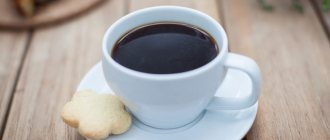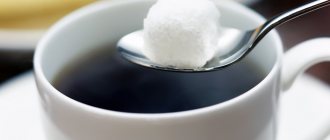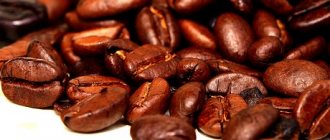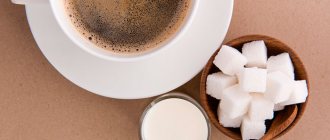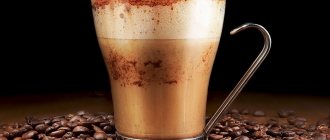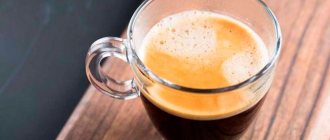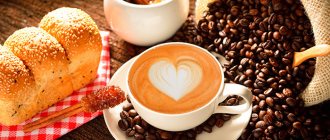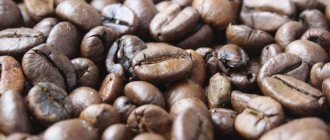Any drink has its own energy value. This indicator is formed by many factors. One of the main ones is composition. But the calorie content of an Americano depends not only on what ingredients the coffee is brewed from. The type of ground product used is important. Another important nuance is the cooking technology.
Type of milk
Milk is the main ingredient in a coffee milkshake, accounting on average for over 50% of the nutritional value. It has a wide range in caloric content: low-fat contains 2 times less calories than whole. The nutritional value of milk coffee is significantly influenced by the fat content of the selected product, and the calorie content of an unsweetened latte depends entirely on it.
Typically cow's milk with a fat content of 2.5% is used. It whips well into foam, tastes good, and is moderately nutritious. Vegetarians add animal milk equivalents (soy, almond, coconut) to coffee-based drinks. But products of plant origin add their own flavor, so not everyone likes them.
Don't miss: Which milk is best for cappuccino and latte in a coffee machine?
| Type of milk | Kcal per 100 g |
| Low fat 0.1% | 34 |
| Pasteurized 1.5% | 44 |
| Pasteurized 2.5% (most common option) | 52 |
| Fat 3.5% | 61 |
| Whole 6% | 64 |
| Vegetable (soy) 1.8% | 54 |
The volume of the latte may vary, but the proportions of coffee and milk are in most cases the same - 1:3. For one part of espresso (30 ml) take 3 parts (90 ml) of milk.
Amount of milk in different servings:
| Total volume, ml | Milk, ml |
| 120 | 90 |
| 180 | 120 |
| 240 | 180 |
| 450 | 340 |
Knowing the calorie content of 100 g of milk and its quantity per serving, it is easy to calculate how many “milk” calories are in a cup. You need to divide the energy value of 100 g of product by 100 and multiply by the number of grams (milliliters) used for cooking.
For example, to determine the calorie content of an “average” 300 ml cup of cocktail with 2.5% fat milk, we carry out the following calculations: 52/100*225=177. These are only “milk” kilocalories. The energy value of espresso can be ignored: there are only 2 calories per 100 g. This means that in 300 ml of a latte without sugar there are 117 kilocalories. Calorie content of 100 g is calculated the other way around. 117/300*100 = 39 kcal.
Benefit
A latte without sugar (the calorie content of the product is given in the article), due to the high milk content, supplies the body with a large amount of the “joy hormone”, which banishes drowsiness and helps fight the consequences of stressful situations.
Among the useful qualities of the product:
- good invigorating effect;
- assistance in restoring strength after suffering serious physical and mental stress;
- weakening of the severity of the manifestation of VSD and accompanying migraine;
- stabilization of potency;
- reducing the risk of developing cancer, Parkinson's disease and liver cirrhosis;
- replenishing the body with calcium and fluorine, which are responsible for the good condition of bones and teeth;
- regulation of the gastrointestinal tract, restoration of intestinal microflora;
- assistance in the treatment and prevention of cardiovascular pathologies;
- as a natural antioxidant reduces the negative impact of free radicals on the body's cells.
A large amount of milk prevents the negative qualities of pure espresso because:
- preventing the aggressive effect of gastric juice, intensely produced under the influence of caffeine, on the walls of the esophagus;
- preventing the leaching of calcium and the antioxidant complex from the body.
Latte is useful for pregnant women, especially those who cannot imagine their day without a cup of coffee. The caffeine contained in the product will help you wake up and invigorate, and a large amount of milk will compensate for the lack of nutrients and prevent an increase in acidity (caused by caffeine) in the body.
Americano coffee: nutritional value, BJU, vitamins and chemical composition
More information about the vitamins in Americano Coffee
Vitamin B2, riboflavin
- the health of hair, skin and nails depends on the amount of this vitamin in the body. Necessary in the process of formation of red blood cells and antibodies when the body encounters viruses. Affects the functioning of the thyroid gland and the reproductive system of the body. Reduces eye fatigue, facilitates the absorption of oxygen by cells.
Vitamin B9, folic acid
- stimulates the reproductive mechanisms of the body, affects the general emotional state of a person. Reduces the risk of malignant neoplasms in women. Participates in hematopoiesis, facilitates the absorption of oxygen by cells, and fights early aging. Activates the synthesis of the “hormone of joy”.
Vitamin PP, nicotinic acid
- thins the blood, increases resistance to atherosclerosis, blocks the accumulation of cholesterol. Participates in protein synthesis, normalizes blood sugar levels. Supports stable functioning of the heart, liver, and intestines. Increases resistance to diseases and has a powerful anti-inflammatory effect.
Other coffee additives
Milk is the most common, but not the only ingredient that can be used in the process of preparing a black drink. Many people add condensed milk, cream, ice cream, and much more. Let's see how many calories they contain and add that data to our calculations. We will take average indicators as a basis.
Whole milk
We already know what the calorie content of coffee without milk depends on. Milk is the second most popular additive to coffee. This is a product rich in fats, proteins and carbohydrates. The energy value of coffee with milk directly depends on the origin of the additive (animal or vegetable) and the percentage of fat content.
One tablespoon of natural whole milk contains:
- 1.5% fat – 9 kcal;
- 2.5 fat content – 11 kcal;
- 3.2 fat content – 12 kcal.
Spices
Special gourmets and lovers of “zest” in taste sometimes add various spices to coffee. Cinnamon, ginger, cardamom, nutmeg, vanilla, cloves and other options are suitable for a coffee aromatic bouquet, it all depends on individual taste preferences. Spices are added in minimal quantities, but even 1 gram of one or another spicy additive can affect the total calorie content of a cup of your favorite drink. The table shows quantitative indicators of the energy value of different types of spices.
Calorie table of popular spices in coffee
| Spices and seasonings | Number of kcal | |
| in 1 g | in 100 g | |
| Cinnamon | 2,5 | 247 |
| Cardamom | 3 | 311 |
| Carnation | 3 | 320 |
| Nutmeg | 5 | 547 |
| Dry ginger | 3,5 | 347 |
| Fresh ginger | 1 | 80 |
| Vanilla | 3,5 | 351 |
It is worth noting that such experiments will not be to everyone’s taste. Therefore, before treating your guests to such spicy drinks, ask about their preferences.
Skimmed milk
People who like the milky taste of coffee but are trying to lose weight or eat a healthy diet often choose skim milk. It has only 0.5% fat content, which gives 35 kcal per 100 mg of product, and only 7 per tablespoon. Although it contains no fat, it retains most of the beneficial microelements, vitamins D, A, PP, C, group B , calcium and potassium, phosphorus, valuable enzymes and amino acids.
Condensed milk
Condensed milk is everyone’s favorite delicacy from childhood, which we gladly added to almost all sweet dishes without spoiling the taste. Therefore, coffee with condensed milk, with its delicate taste, seems to send us back to that carefree time. This is a great option for replacing milk or cream if you suddenly run out. But it is worth remembering that this is a fairly high-calorie product: 100 grams contain 300 kcal. This means that the calorie content of coffee with condensed milk increases by 36 kilocalories with each teaspoon, and by 75 kilocalories with each tablespoon.
There is a special type of condensed milk - without sugar, its energy value is 2.5 times less than a regular product.
Per 100 grams of product - 295 kcal. A teaspoon - 29 kcal.
Natural drink made from ground grains
If a ground product of natural origin is used to prepare Americano, rather than instant, the calorie content is significantly lower. As a result of brewing using European technology, the energy value is always the same.
Regardless of the volume of water, this is approximately 2 kcal. In the case of brewing using the American method (in a drip coffee maker), the ratio is as follows:
In a serving of 100 g. contains 2.5 kcal;
- A 200-gram bottle contains 5 kcal;
- At 240 gr. – 7 kcal;
- 300 grams – 9 kcal;
- Energy value of a large portion of 450 g. drink – 15 kcal.
As a rule, our establishments use espresso-based brewing technology.
Where to begin?
Few people know the recipe for Americano coffee. First, let's find out how espresso is prepared. It should be noted that the basic recipe for fragrant American-style coffee can be mastered by every owner of a coffee drip device. The choice falls on this coffee maker, since it supplies water without pressure and the drink does not come out strong. Espresso is prepared for no more than 25 seconds at 85 °C. His recipe in the American standard version looks like this. We take:
- 220 ml purified water;
- coffee beans - 2 tbsp. l.
Manufacturing process:
- Grind the grains. You should get 15-16 g of finely ground raw materials.
- Add water and brew espresso.
Calorie content of types of coffee
If you are on a strict diet, or counting calories to stay in shape, taking into account the calorie content of coffee is just as important as the energy value of any product. Natural
The calorie content of bean coffee without additives is from 3 to 7 calories per 1 tsp. (220-270 kcal per 100 g) - depending on the variety. Coffee beans contain fats, proteins, carbohydrates, essential oils and minerals. Roasting and grinding reduce the energy value of the grains. Remember that when brewing it also decreases. That is, you can drink brewed coffee without additives without any harm to your figure. For example, the calorie content of 50 ml of Americano is 2 calories, and 100 ml of double espresso is 4 calories.
Natural. The calorie content of bean coffee without additives is from 3 to 7 calories per 1 tsp. (220-270 kcal per 100 g) - depending on the variety. Coffee beans contain fats, proteins, carbohydrates, essential oils and minerals. Roasting and grinding reduce the energy value of the grains. Remember that when brewing it also decreases. That is, you can drink brewed coffee without additives without any harm to your figure. For example, the calorie content of 50 ml of Americano is 2 calories, and 100 ml of double espresso is 4 calories.
Soluble. It can be granulated, sublimated and powdered. A teaspoon of instant coffee contains 5 calories (180-230 per 100 g of product).
With sugar. 1 tablespoon of sugar (25 g) contains 57 calories, and a teaspoon - 27. For example, if at home you prefer to drink brewed coffee (2 tsp) from a 250 ml mug, add 2 teaspoons of sugar to 10 (calories of coffee) add 54 (calories of two teaspoons of sugar) and in the end we get 64 calories per mug.
With milk. Depends on the milk. For example, to prepare coffee drinks in coffee shops, as a rule, milk with a fat content of 3.2% is used. 100 ml of this milk contains 58 calories. When preparing it yourself, you can reduce the calorie content by choosing milk with a lower fat content. So, 100 ml of milk with 2.5% fat content contains 50 calories, and 1.5% milk contains 43. To determine the amount of milk, use a measuring cup. For example, to prepare according to the classic recipe (proportion – 2 tsp of ground coffee per 100 ml of water + 100 ml of milk), you can take milk with 2.5% fat content. To calculate calories, you need to add 50 (calories of milk) to 10 (calories of coffee). You get 60 calories per 200 ml.
With sugar and milk. It all depends on the proportions and fat content of the milk. For example, the calorie content of 250 ml of drink (2 tsp of natural coffee per 200 ml of water, 2 tsp of sugar and 50 ml of milk 3.2% fat) will be 90 calories.
With cream. Cream increases the caloric content of any drink. For example, 100 g of cream (10% fat) contains 86 calories, and one tablespoon of cream contains 22. If you add 2 tablespoons of cream (44 calories) to coffee (2 teaspoons per 200 ml of water = 10 calories) - get a drink with 54 calories. And if you also add 2 teaspoons of sugar, there will be 108 calories per 200 ml.
3 in 1. The calorie content of coffee from sticks significantly exceeds the energy value of coffee without additives. The weight of the Nescafe 3 in 1 stick is 17.2 g. Since the composition includes instant coffee, dry cream and sugar, the calorie content of one stick portion is 70 calories.
Latte. Latte is a cocktail that is prepared according to different recipes. In the traditional sense, it is “espresso”, milk (no more than 60-70 degrees) and milk foam in a ratio of 1:2:1. The energy value depends on the ingredients. To prepare a latte according to the classic recipe (200 ml), 150 ml of 3.2% fat milk and 50 ml of espresso are used. Thus, the calorie content of a sugar-free latte will be 95 calories. Sugar is added as desired, but if you are used to putting 2 teaspoons in your coffee, you get 149 calories in 200 ml of a classic latte.
Cappuccino. Cappuccino is prepared on the basis of espresso with milk (3.2% fat) and milk foam. The concentration of coffee in a cappuccino is higher than in a latte. Traditionally it is served in a 180 ml cup. Thus, a standard serving of cappuccino (without sugar) contains 60 calories.
Glyase. Glace coffee is also prepared on the basis of espresso with ice cream. The energy value of the drink depends on the fat content of the ice cream. As a rule, ice cream with 8% fat content is used. Glace according to the classic recipe (50 ml espresso + 50 g ice cream + 1 tablespoon sugar) contains 170 calories.
To gain harmony, you don’t have to deny yourself such pleasures as coffee drinks. If it contains more than 200 calories, it is better to drink it before 14:00, and ideally for breakfast. Also, do not forget to move more, eat natural foods, drink clean water and do not snack on cakes and sweets. Then excess weight will not threaten your figure.
Properties of Americano coffee
Nutritional value and composition | Vitamins | Minerals
How much does Americano coffee cost (average price for 1 cup)?
Moscow and Moscow region.
30 rub.
Few people know that Americano coffee is a subspecies, or rather one of the options for making espresso coffee. Americano coffee was incredibly popular in the North American region. It is for this reason that the drink received its original name. The composition of Americano coffee and espresso is the same, only the method of preparing the drink differs. Much more water is added to Americano coffee.
Some fans of Americano coffee argue that the drink compares favorably with espresso because it contains much less caffeine in the chemical composition. This double statement is partly confirmed by the results of scientific studies of the effect of coffee on the human body. However, there are several types of Americano coffee, which differ from each other not only in taste or aroma, but also in the chemical composition of the drink. The following types of Americano coffee are distinguished:
- American coffee or Americano is prepared at a temperature of 85C in a filter coffee maker;
- European Americano is brewed with boiling water;
- Scandinavian (Swedish) Americano;
- Americano iced coffee is made using cold water or ice;
- Americano Red Eye or Canadino.
It is noteworthy that the first two types of Americano coffee are considered classic or basic types of drink and differ not only in the temperature of the brewing water. The American and European versions of Americano coffee are made from the same amount of coffee. However, European Americano coffee has a smaller volume of water. Only 120 ml versus 220 ml in the American version of the drink. Therefore, it is more correct to call European Americano classic espresso coffee, which is served in one small cup, and in the other, hot water is often served in order to dilute the coffee and prepare Americano.
The Italians, recognized connoisseurs of espresso coffee, claim that it was they who gave the name to the new drink. During World War II, American soldiers often ordered a “cup of Joe” or a cup of coffee, which they were accustomed to in their homeland, in Italian cafes and bars. The Italians prepared espresso in a coffee machine and then diluted it with water. The result was an original drink, which began to be called Americano coffee, from the nickname of American soldiers.
Surprisingly, Americano coffee spread throughout Europe and became the favorite drink of many coffee lovers. But in the USA, Americano coffee gained popularity in the 90s of the last century, thanks to the Starbucks cafeteria chain. Americano coffee is made from several shots of espresso coffee to which 30 to 470 ml of hot water is added. Beginners can easily ruin their Americano coffee if they leave it in the machine too long. Then the drink will taste bitter and smell unpleasant. In addition, improperly prepared Americano coffee can cause significant harm to human health, because... contains harmful resins and carcinogenic substances in its chemical composition.
Calorie content of coffee with additives
It is rare to find lovers of black coffee without additives: milk, cream, sugar, spices - all this gives the drink new dimensions of taste and aroma, and at the same time - calories.
Milk and cream
Cream perfectly softens the taste of coffee, but significantly increases the number of calories. Usually about 30 ml of milk or cream is added to a cup of black drink. If milk has a fat content of 2.5%, it will add another 16 kcal to coffee; if it is fattier, 3.2% will add 18 kcal. The cream is twice as fat, i.e. will complement the calorie content of coffee by approximately 36 kcal.
Sugar
Sugar greatly increases the calorie content of the drink, a teaspoon of sugar has 24 Kcal, respectively, adding two tablespoons of sugar, we get 48 Kcal. A teaspoon or stick bag with sugar contains about 5 grams of weight, which means that one such serving will make the drink more caloric by 20 kcal, and since one spoon is often not enough, this figure increases by 2 or even 3 times.
Condensed milk
Condensed milk is perfect for coffee, as it not only softens its taste, but also makes it sweet and, accordingly, more caloric. This delicacy has an energy value of 320 kcal per 100 g, therefore, two teaspoons of condensed milk will add another 64 kcal to coffee.
Cognac
Cognac will enrich the taste of coffee and add additional calories to it. Noble alcohol reveals the taste of even the most inexpensive coffee in a special way. However, taking into account that preparing proper coffee with cognac requires about 30 ml of the drink, and its energy value is 239 kcal/100 ml, this results in an increase of 69 kcal per serving.
Liquor
Lovers of coffee with liqueur understand that a tasty additive can cause extra pounds. A sophisticated drink based on berries and spices will add about 60-90 kcal to a cup of coffee when adding 30 ml.
Syrups
A tablespoon will hold 25 grams of syrup, and a teaspoon will hold 10 grams; the calorie content of the drink will increase in proportion to this. A sweet additive in the form of syrup flavored with chocolate, caramel or vanilla will increase the calorie content of coffee several times, because 2 teaspoons of the delicacy contain 78 kcal.
Spices
Almost all spices have a low calorie content, which will have a great effect on your figure. But adding spices (cinnamon, cardamom, vanilla, ginger) to a hot drink will not only give it unique shades of taste and aroma, but will also have virtually no effect on the energy value - per teaspoon spices no more than 3.5 kcal. The exception is nutmeg - its calorie content per 10 grams is 5 kcal.
Calorie content of coffee 3 in 1
What is espresso coffee, how to prepare and serve it correctly
A standard 3 in 1 coffee bag is a mixture of coffee, sugar, milk powder
A sachet of 3-in-1 instant drink usually contains 20 grams of powder, and the calorie content indicated by the manufacturer varies from 80 to 100 kcal. It turns out that 100 grams of such coffee contains from 300 to 500 kcal, which is several times higher than the energy value of regular coffee.
The main component of the 3 in 1 drink is sugar; it contains about half of the total weight in a standard bag, which means its calorie content is 38 kcal. Coffee, as already mentioned, is a low-calorie component. The last component is cream, 100 grams of this product of plant origin contain 450 kcal, if there are 5-7 grams in a bag, then it adds 30-35 kcal.
Aromatic and flavoring additives increase the calorie content of such coffee even more.
Unfortunately, an unscrupulous manufacturer makes an already high-calorie instant drink even more harmful to the figure, replacing natural coffee with wheat, oak acorns, chestnuts and other cheap raw materials. Flavoring additives such as “chocolate”, “condensed milk” or “hazelnut” increase the calorie content of 3 in 1 coffee by an average of 15-40 kcal per serving; preservatives, often not listed in the composition, also add “weight”.
Instant coffee lovers do not have to worry about extra pounds and enjoy the taste and aroma. However, it should be remembered that any additive affects the calorie content of the drink. Drinking a few cups of coffee a day with milk, cream or sugar can provide up to 30% of your daily calorie intake and should be taken into account.
For many, a new day begins with a cup of invigorating strong espresso, a gentle latte is drunk at lunch, and the work day ends with a sweet cappuccino. The calorie content of coffee depends on the variety, type, ingredients, their quantity and volume, recipe and other nuances.
Cooking technology: what depends on it
There are two technologies for preparing Americano. It is customary to distinguish between a European and an American drink. The latter is brewed in a drip coffee maker. The principle is as follows: water, influenced by gravity, passes through the ground product.
As a result, the drink is more bitter and contains more caffeine. Since more sugars, lipids and other substances are transferred into the liquid, the calorie content of Americano from a drip coffee maker is 2.5 kcal per 100 g.
The European drink was invented by the Italians. Preparation principle: coffee is brewed in a coffee machine or Turk and diluted with boiled water until the required volume is obtained. Since the first ingredient is cooked quickly, the liquid does not have time to be fully saturated with caffeine and other components of the ground product. The taste of the European drink is milder than the American one, its nutritional value is from 2 to 2.2 kcal per serving.
It turns out that the calorie content of Americano Long Black (American) is slightly higher. In addition, based on the peculiarities of the technology for preparing the American drink, we can come to the conclusion: the larger the volume of water, the higher the energy value, since the microelements of coffee beans enrich the liquid.
In the case of a European drink, it is different: no matter how much water is diluted with espresso, the final product will contain no more than 2.2 kcal per serving.
How many calories are in a spoon of coffee?
Calorie content of ground coffee
Coffee contains an extremely small amount of calories, so this drink in its pure form is not one of those that will add extra pounds. This can be proven using banal mathematics. And we'll start with ground coffee. But first we need the following information: one teaspoon
ground coffee holds approximately 4 grams (if you scoop up coffee without a slide) or 5-6 grams of product (if you scoop up a spoon of coffee with a slide).
Next, in order not to be unfounded, we recommend picking up a package of natural ground coffee. Read the nutritional
, which is usually present on the packaging or on an additional sticker placed on a pack of coffee.
Calorie content of Americano from instant coffee
The energy value of ground Robusta beans, from which instant coffee is made, is lower compared to Arabica. However, the production technology involves the addition of various stabilizers and dyes.
Manufacturers often add corn flour and other fillers, for example, in the form of chicory. All these components increase the calorie content of Americano from instant powder or granules. The nutritional value of the drink in this case is 10 kcal. In this case, the serving size does not matter.
How many calories are in coffee without sugar?
How many calories are in a cup of coffee
So now we know that a teaspoon of pure ground coffee contains approximately 8-12 kilocalories, while a teaspoon
instant coffee contains about 2.5-3.5 kilocalories of product. Does the number of calories change during the final preparation of the product, that is, when preparing a coffee drink?
The answer is clear - if it changes, then only to a lesser extent. And these changes are extremely minor.
Fans of double espresso (doppio), which is essentially the same espresso, only with double the amount
water and coffee (that is, approximately 60 grams of water for 14-20 grams of coffee), consumed with one serving of the drink without additives from 28 to 40 kilocalories.
Americano is a coffee drink for those who do not like a very concentrated coffee taste. Essentially, an Americano is a highly diluted espresso or double espresso. Moreover, according to the classic cooking
, it can be diluted in almost half a liter of water. Thus, the calorie content of one cup of classic Americano made from ground coffee is the same 14-20 kilocalories.
It is well known that the recommended calorie intake per day for women is 2000 kilocalories, and for men – 2500 kilocalories. Of course, these are average data
, since this norm depends on age, body weight, type of activity, health status, climate and many, many other factors. Conclusion: then a couple of cups of coffee without additives
per day do not pose any danger in terms of the risk of gaining excess weight.
Coffee with milk without sugar - calorie content of instant coffee and natural coffee
Many people enjoy invigorating coffee. Lovers of the aromatic drink do not forget to watch calories. Let's see how to calculate the calorie content of coffee with milk.
Compound
The natural product contains caffeine, which stimulates the nervous system and contains few calories. One serving of coffee beans contains about 60% carbohydrates, 10% proteins, and 15-20% fats.
Benefit
The drink is good for the body. It tones, improves memory and attention, and reduces the risk of cancer. But in combination with sugar and milk, black coffee acts differently, softer and slower.
Coffee addiction is not a disease; an invigorating drink will help you avoid Parkinson’s and Alzheimer’s diseases. But before a long journey, the aromatic sweet drink with milk should be consumed carefully, it has a diuretic effect.
Milk can prevent esophageal cancer. If you add it to a flavored drink, calcium will be absorbed better.
Harm
Too hot can cause thermal burns to the tissues of the esophagus. By adding milk, the temperature will drop and there will be no harm to the stomach. Drinking boiled black coffee interferes with calcium absorption.
A thousand and one additions
Carbohydrates are not transferred into the drink during preparation. Frying and grinding do not affect calorie content.
The grains contain 2% glucose and fructose. They determine the calorie content of the invigorating drink. It contains almost no calories and even a few cups a day will not ruin your figure.
If sugar or milk is added, the calorie content will be different.
- The most dangerous product is sugar. Two spoons in one cup will add 50 kcal.
- When adding 100 ml of milk, the calorie content will increase by 50.
- A product with a fat content of 3.2% will add 65 kcal.
- With low fat it will be 30 more calories.
- Cream. Just 10 grams will add 20 to 60 calories.
- Chocolate syrup. One teaspoon will add 15 calories to the treat.
- Ice cream. One 50 gram ball will increase the calorie content by 113.5.
Coffee with milk and honey will be beneficial; it contains 78.5 units per 100 grams of product.
Calorie content
The drink itself is considered a low-calorie product; a cup without sweet additives contains two kilocalories per 100 grams.
With the classic popularity of black coffee, connoisseurs add honey, milk and other additives to it. They make the taste special.
The most popular additive is milk. It gives a mild taste and reduces the effect on the body. Women especially appreciate the velvety taste of coffee with milk, but do not forget about its calorie content. Let's figure out whether a drink with added milk poses a threat to an ideal figure.
Milk is a product with a certain fat content. The store product contains either 2.5% or 3.2%. For this reason, coffee cannot be low-calorie. Adding a homemade product will make the drink tastier, but it will also have more fat. Contains 27 kcal, soluble – 25.4.
Diet
For those who constantly adhere to a diet, it is important to know the nutritional value of coffee with milk without sugar. One hundred grams of product contains:
- Proteins – 1.77, 2% of the daily value.
- Fats – 1.39, only 1% of the norm.
- Carbohydrates – 2.66, 0% of the daily value.
In total, a cup of coffee with milk without sugar contains 26.91 kcal, 2% of the daily value in 2000. If you are on a diet, a portion will not harm. Even a whole mug without additives will not give you extra centimeters.
Let's keep score
If you are watching your weight and controlling the number of calories, it is better to count them separately.
For example, if you decide to drink a drink with sugar, then when calculating you should add the number of calories contained in two spoons of the sweet additive. This makes it easier to keep your own diet under control.
Account Features
Black coffee, even 3-4 cups will not add more than 25 calories. Everyone without exception can drink the drink without fear.
An aromatic drink brewed in a Turk or French press will add 4 kcal. Freeze-dried soluble – 10, granular soluble – only 5.
Green contains no calories. But if you add 1-2 tablespoons of sugar, its energy value will increase.
With sugar
One level teaspoon – 20 kcal. The same amount is contained in a bag or cube of refined sugar; they are often offered in cafes. In a heaped spoon - 28 grams.
- Espresso has only two calories, a spoonful of sugar will add another 22.
- Americano from a coffee machine - 4 kcal, one spoon of sugar will add 24 calories, two - 44.
- In a cup of cezve – 4, sweet – 44.
- The same amount in the French press version.
- Decaffeinated - no different from the French press version.
- Instant freeze-dried 10, with sugar 30 and 50 respectively.
- And soluble in granules - 5, with added sugar - 25 or 48.
Ground or instant
Coffee is present in a variety of diets due to its low calorie content. A healthy drink increases energy consumption and speeds up metabolism.
But the statement is true only for black coffee. And in this case, do not forget that the less liquid consumed per cup, the higher the calorie content:
- Americano contains only 2 kcal.
- Double espresso – 4.
- In Turkish – 12.
- With cream – 22.
The data is valid for the option without additives. The list shows calories per 100 grams.
The product with sugar is suitable for those who exercise intensively; it can restore strength. For those lovers who do not expend a large amount of energy, a sweet favorite drink with milk will lead to the appearance of additional kilograms.
Coffee that does not require cooking is bad for your figure; its calorie content without sugar is 68.
Five cups are equal in calories to two bars of milk chocolate. One cup is close in calories to a plate of hearty goulash.
Soluble, according to gourmets, is inferior to natural. But there are quite decent brands, for example, Nescafe. It is sold both in pure form and 3 in 1.
Nescafe is in fourth place in the ranking among its brothers.
It needs to be cooked correctly. A fragrant cup of Nescafe can give pleasure. And there are also benefits in combining coffee with milk and honey.
The option in portioned packages is convenient, but it contains vegetable cream. The calorie content of coffee is high, for example, one bag of McCafe contains 84 kcal, and in one serving. If you calculate the BJU, it turns out that fat is 1.6 grams, carbohydrates are 17.2 grams, proteins are 0.6 grams.
With this method of preparation, calorie content should be considered.
With milk
If you prepare your favorite drink at home, you can personally calculate the calorie content.
The nutritional value of the products is indicated on the packaging. Here is a table of calorie content for different types of milk:
- Fat content 2.5 – 52 kcal per 100 grams.
- At 3.2% – 58.
- Homemade, with a fat content of 3.8, contains 69 calories.
- Ghee – 68, with a fat content of 4%.
- Condensed at 5% fat, it will add 75 kcal.
- Condensed with sugar – 270, with a fat content of 2.5%.
- Soy contains 54 calories, with 1.8% fat content.
It is better to drink coffee with condensed milk without sugar.
Supplements
Any ingredient that ends up in the mug will add:
- one serving of syrup – 20 kcal;
- topping – 15;
- with cinnamon and cloves – 3;
- cream, 10 grams – 12;
- cream 20% (10 g) – 20;
- spoon of whipped cream – 56.
Add chocolate to coffee with milk and enjoy the taste.
Calorie content without any additives is not taken into account. Two spoons of sugar can harm your figure. A cup of an invigorating treat can be beneficial.
This fragrant product will give true connoisseurs many pleasant moments.
How many calories are in a cup of coffee with sugar?
The fruits of the coffee tree themselves are quite high in calories. Roasted coffee beans have a calorie content of 223 kcal per 100 grams. But not all of these calories end up in the finished drink, since water-soluble substances in it make up only 20-29%. Therefore, the nutritional value of black coffee in its ready-to-drink form is 2 Kcal per 100g.
Few people drink coffee in its pure form without any additional ingredients. To improve and soften its taste, sugar, milk, cream, various liqueurs, all kinds of syrups, honey, ice cream, chocolate and much more are added. It is these components and the chosen method of preparation that determine the calorie content of this ancient drink.
The average calorie content of coffee without sugar is 2 Kcal per 100 ml volume. Americano contains 1 kcal, espresso 4 kcal of energy. The calorie content of instant coffee “without impurities” is 7 Kcal.
To calculate how many calories are in a cup of coffee, take an average 250 ml cup. It turns out that a cup of natural coffee without various additives contains only 5 Kcal, while instant coffee contains 17.5 Kcal. When you add other ingredients, the number of calories will immediately increase.
On average, one teaspoon of sugar has an energy value of 24 kcal. Dairy cream (35%) contains 340 Kcal (per 100 ml), vegetable cream – 30 Kcal. Milk with a fat content of 3.5% has an energy value of 60-65 kcal.
Knowing how many calories are in coffee without sugar, you can easily calculate the energy content of coffee in combination with these components. First, let's find out how many calories are in coffee with sugar.
Popular articles for weight loss and health
Chia pudding: recipe with coconut milk
Diet 5 spoons: menu for the week real reviews
Granola at home dietary recipe One Glass Diet
Let's imagine that three teaspoons of sugar are placed in a cup with a capacity of 250 ml. It turns out that a cup of freshly brewed coffee with sugar will have a caloric content of 77 calories.
In a similar way, you can calculate how many calories are in coffee with milk. If we imagine that 50 ml of milk is added to a standard cup, then through simple calculations we find that the calorie content of coffee with milk without sugar will be approximately 34 Kcal (in a 250 ml cup).
A cup of coffee with heavy cream without added sugar contains about 174 kcal. The calorie content of coffee with milk and sugar will be equal to 106 Kcal of energy.
Alcoholic and non-alcoholic liqueurs, syrups, chocolate, cinnamon, ice cream, condensed milk, honey, lemon, and egg yolk are often added to this Arabic drink. With these additions, coffee will significantly change its energy value.
Calorie content of a cup of coffee with milk
Many people like adding milk. But with such an additive, even a low-calorie Americano becomes unsafe for the figure. Please note that 100 grams of the drink have 58 calories, and a regular mug (250 ml) has about 145. The larger the Americano mug, the more calories.
Americano with milk is occasionally drunk without sugar, increasing the calorie content significantly with this component. Drinking it while on a diet is definitely contraindicated; it does not promote weight loss. Americano with milk and a bite with buns is perfect for consumption after exhausting sports exercises to regain lost strength.
A latte consists of espresso, milk and foam. Latte differs from the usual Americano with milk in its coffee base and serving method. The most high-calorie ingredient on this list is milk, and therefore the “weight” of a mug of latte directly depends on its quantity. A standard latte contains about 250 kcal, without adding a packet of sugar. By decreasing or increasing the amount of milk in a latte, you can regulate the number of calories, but changing the standard proportions will entail a change in the usual taste.
This drink of Italian origin contains espresso and some high-calorie ingredients. First of all, this is cream (milk). The milk foam that covers the surface of a cappuccino is usually frothed from full-fat milk. To enhance the taste, add one or two spoons of sugar. Therefore, such a cappuccino cannot have a low calorie content, taking into account the constituent elements.
A cup of cappuccino has a volume of 150–180 g. The approximate ratio of frothed milk and coffee (usually espresso, less often Americano) is 6 to one. A standard serving contains about 150 grams of milk and 30 grams of espresso. Two spoons of sugar – another plus 40 kcal. A full serving contains approximately 208–210 kcal. Cappuccino is not the best choice if you are hoping to lose weight.
Americano calories.
Millions of people around the world drink Americano once a day. This is a drink that consists of water and coffee, it is simply prepared using different methods and is familiar to almost everyone. In any country you can ask for an Americano, and you understand what the drink will taste like. The calorie content of Americano is quite low; it is one of the less calorie drinks in general, unless, of course, you add sugar or milk to it. But what does caloric intake depend on, and how to calculate it? The energy value of the drink depends on several reasons: production method, type of coffee (natural or instant), type of beans (Arabica or Robusta).
Is it possible to drink coffee on a diet?
When a person is on a diet, he counts each calorie consumed so that more than the norm does not enter the body. However, this does not mean that you need to completely abandon the natural, familiar stimulants that nature itself gives people. Not at all! If we are talking about black coffee without sugar, then its calorie content is simply scanty. Therefore, even those who strictly monitor their figure can drink it (of course, not forgetting about moderation). According to doctors, five to six cups of 100 milliliters is a safe limit per day for the body. Moreover, coffee contains substances that dull appetite and increase feelings of satiety - and this is just good for a diet. And the presence of caffeine does not affect calorie content, so there is no point in replacing regular coffee with decaffeinated coffee (or chicory in general) (unless, of course, the doctor has given the appropriate recommendation).
Another thing is types containing various additives. Their energy value is very high, so it is worth excluding such drinks from your diet (or at least significantly reducing consumption).
How many calories are in 100 grams of coffee?
Coffee itself has very low calorie content. Given this and its ability to speed up metabolism, this drink is used by nutritionists. The method of preparing coffee, the type and amount of additives used directly affect the calorie content. No matter what we add to a mug of coffee, the number of calories will increase, so if you want to lose weight, it is better to avoid additives.
For overweight people, daily consumption of cappuccino, Viennese coffee or ice cream with ice cream will not benefit their figure. Such drinks are recommended for those who burn a lot of calories a day (for example, people with heavy physical activity, athletes), because they can replenish the energy spent with a coffee cocktail with cream and sugar.
The calorie content of coffee drinks depends on their composition. Instant coffee can contain not only beans, but also certain cereals, flavorings, chicory, and ground nuts. Milk and cream are added to espresso and Americano. The more there are, the “heavier” its “weight”.
The main types of coffee and drinks produced from it:
- Natural (espresso, Americano).
- Soluble.
- Latte.
- Cappuccino.
- Mocaccino.
In black natural
Black custard has the lowest calorie content. There are only 2 kcal per 100 ml. Good news for lovers of Americano - it contains only 1 kcal, espresso a little more - 4. These few calories appear due to the tiny amount of fatty oils and protein found in the beans. Because of these oils, coffee sometimes tastes bad - if slightly over-roasted beans are stored on the shelf for a long time, the extracted oils begin to deteriorate, adding bitterness. If you drink only an Americano or espresso with water, then you don’t have to worry about calories, since there are very few of them.
In soluble
The calorie content of instant coffee is slightly higher than natural coffee and is 7 kcal per 100 ml. A standard mug has a capacity of 250 ml, which means that after drinking it, you will only get 17.5 kcal. If you decide to add 2 teaspoons of sugar to this mug, you will increase the calorie content to 71.5. A person who consumes 2-3 mugs every day receives 210-290 kcal, which is clearly not suitable for those who want to lose weight.
Instant coffee is much faster and much easier to prepare than natural coffee, but its beneficial properties are significantly inferior to the latter. It also contains a lot of caffeine, which greatly stimulates the central nervous system. Therefore, drinking natural grain or ground coffee is both tastier and healthier.
Bzhu and kbzhu coffee per 100 grams
Coffee itself is low-calorie, with no more than 24 kcal per 100 ml. But this statement is true if you drink it without milk, sugar, cream, ice cream and do not eat pastries or cakes. Therefore, without any additives, it can be consumed even on mono-diets.
It contains few micronutrients. Vitamin RR and NE - 0.6 mg, with a norm of 20 mg per day. Potassium 38 mg (2500 mg), phosphorus only 7 mg, at normal levels - 800 mg and calcium 5 mg (1000 mg).
With milk and sugar
It’s easier to count the calorie content of a drink separately, that is, for each component. One teaspoon of refined white sugar contains 25 kcal, and one teaspoon of brown cane sugar contains 15 kcal. If you use a sweetener, the energy value will not increase at all.
50 ml of skim milk contains 15 kcal, and whole milk contains 24 units.
If you cook with the addition of cane sugar and skim milk, then 100 ml of kbju will be equal to:
- 0.31 g protein;
- 0.14 g fat;
- 7.14 g carbohydrates.
Calorie content is 34 units.
If we are talking about “Cappuccino”, then the calorie content of a standard 180 ml portion is equal to 200 units, since the composition also includes cream and sugar. When consumed three times a day, such a drink will account for a quarter of the total possible daily calorie intake.
“Latte” is prepared using milk, which has a high fat content. Even if you do not add sugar, then 200 ml accounts for 95 kcal, and if you add sugar, the nutritional value increases to 149 units.
“Moccaccino” is the leader in calorie content. There are 290 kcal per 200 ml. It is prepared from natural ground coffee, with the addition of full-fat milk and chocolate syrup.
Cream adds more calories. The safest are vegetable liquid ones, 1 tablespoon contains from 10 to 20 kcal. And in dry ones from 30 to 50 units, the leaders in nutritional value are whipped, fatty – 50 kcal.
Those who love ice cream should also be careful, adding literally 50 g, you add + 113.5 units to the calorie content. A teaspoon of condensed milk will add 35 units, and a teaspoon of chocolate syrup will add 15 units.
With milk without sugar
You can drink coffee with milk without sugar, then the kbju will be equal to:
- 1.78 g of protein or 2% of the RSP;
- 1.41 g fat, 1%;
- 2.68 g carbohydrates, 1%.
Nutritional value of 100 ml - 26.7 kcal. The calculation is based on the use of whole milk.
Find out how to lose weight without hunger
No sugar and no milk
Kbju coffee 100 g is:
- 13.9 g protein;
- 14.4 g fat;
- 4.1 g carbohydrates.
The energy value is 200.6 kcal.
One tablespoon contains 12-18 g of ground grains with a hill, in a teaspoon from 4 to 6 g. This difference in numbers is due to the fact that the grains have different grinding. The smaller it is, the more it can fit in a spoon. The same rule applies to soluble, freeze-dried, granulated will be less in a spoon than in powder form.
Per 100 ml usually add 1-2 teaspoons. Accordingly, if you add 2 tsp, without any other additives, the calorie content of the drink will be from 16 to 24 units.
The most harmless drinks include Americano and Expresso without the addition of milk, cream and sugar. Frappe is considered low-calorie, but on the condition that there is nothing in it except water and ground grains. The drink is prepared by whipping coffee with cold water and ice. Its calorie content is the same as the two above.
It is a misconception that green coffee has less calories than black coffee. Bzhu 100 g of product is equal to:
- 12.3 g protein;
- 0.2 g fat;
- 35.7 g carbohydrates.
Nutritional value – 222 kcal. It is obtained by drying the grains rather than roasting them. In this form, they retain large quantities of antioxidants, tannins and caffeine. Therefore, you should not unequivocally believe what they write about “magical” properties for weight loss. In fact, green and roasted grains actually improve lymphatic drainage, enhance physical and mental activity, but do not in any way affect the weight loss process.
It is not recommended to replace sugar with a sweetener. It really won’t add extra calories to the drink, but it will provoke appetite, so it’s too difficult to resist the temptation to eat something tasty along with a cup of aromatic drink.
Soluble and ground
All packages of instant coffee indicate the calorie content of 100 g of the product, regardless of the manufacturer and country of origin. Average instant coffee:
- 15 g proteins;
- 3.6 g fat;
- 7 g carbohydrates.
Calorie content of 100 g is equal to 118.7 units.
If we are talking about a “3 in 1” bag, then the situation is completely different. In addition to granules, it contains milk powder and sugar. Therefore, the calorie content of 1 stick is on average 70 units.
The real leader in terms of minimum calorie content is granulated Nescafe Gold - 49 units. For example, 100 g of Black Gold Card contains 92.4 kcal, and Ambassador contains 329 units.
